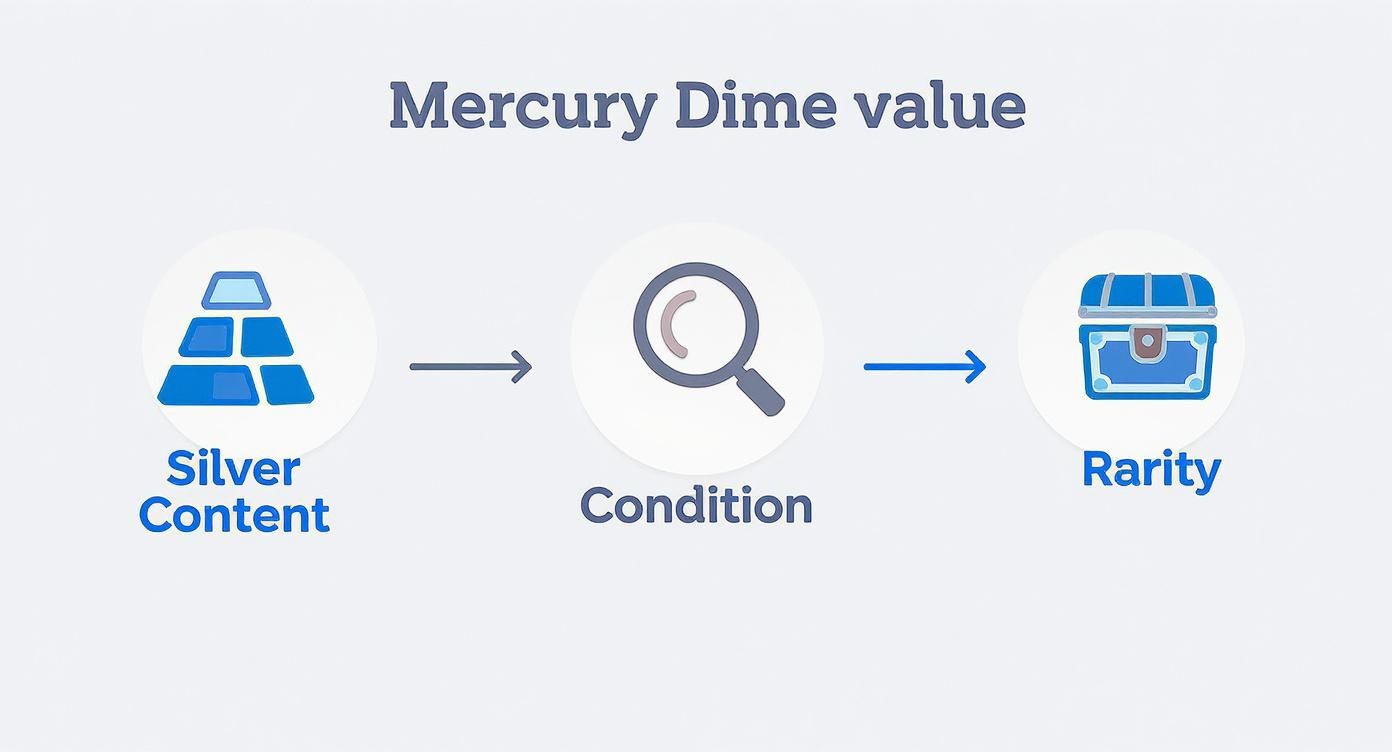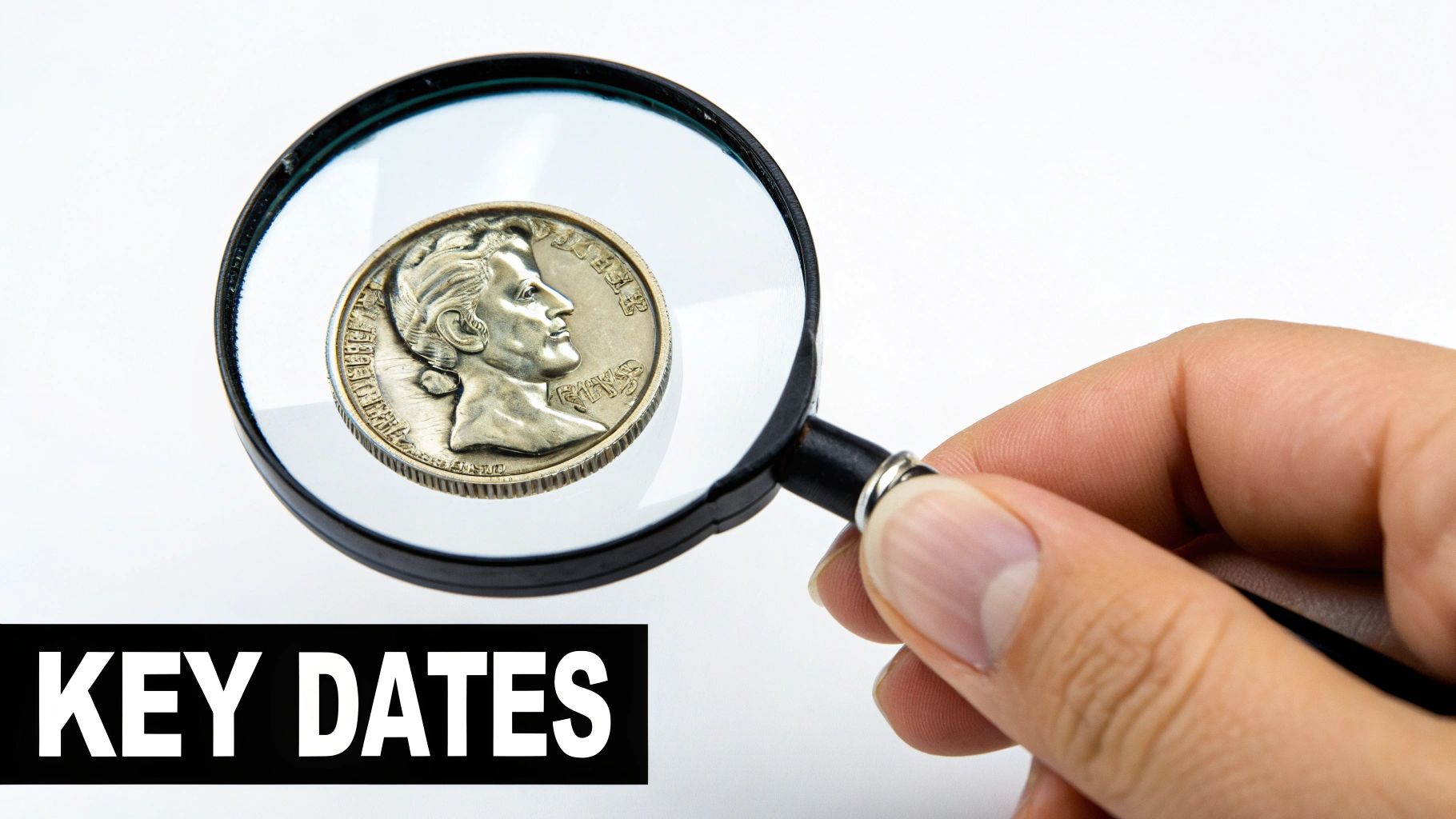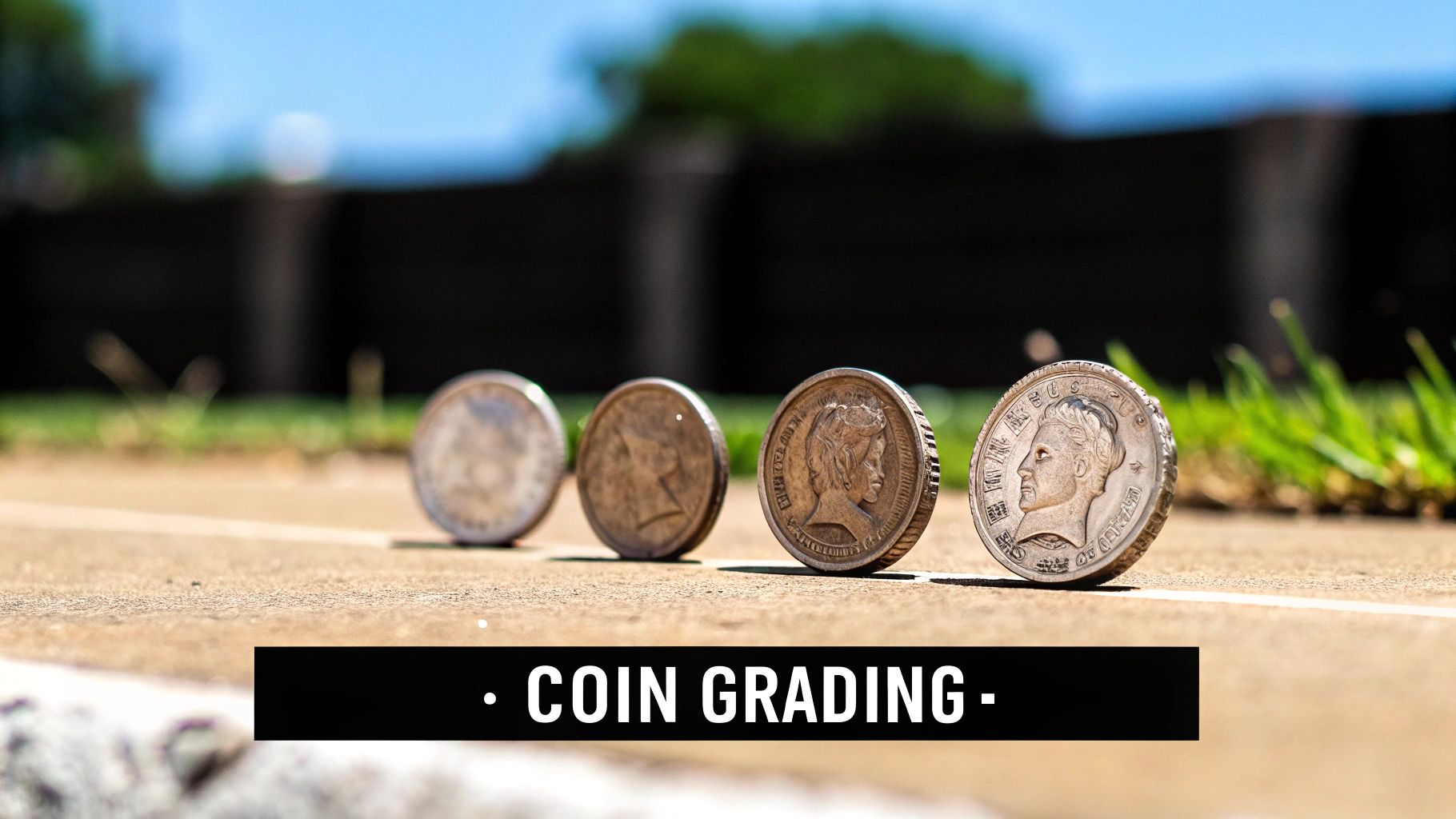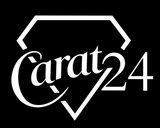The value of a Mercury dime isn't just one number—it's a whole spectrum. At the very least, every single Mercury dime is worth more than ten cents because of its 90% silver content. This gives it a built-in "melt value" that acts as a floor.
On the other end of that spectrum, a rare, perfectly preserved dime can be worth thousands of dollars. It's a true numismatic treasure.
Unlocking Your Mercury Dime Value
Figuring out what your Mercury dime is worth is like solving a three-part puzzle. The final price tag comes down to a mix of its silver content, its physical condition (the grade), and how rare it is. These three factors all play off each other, and a top-tier score in one area can sometimes make up for a weakness in another.
This visual guide breaks down the core elements that drive a Mercury dime's value from a few bucks to a small fortune.

As you can see, the journey to a final valuation starts with that foundational silver content, then moves up through the coin's physical shape, and finally gets a huge boost from its specific rarity.
To give you a clearer picture, here’s a quick look at the huge range of potential values.
Mercury Dime Value At a Glance
| Coin Type / Condition | Typical Value Range |
|---|---|
| Common Date (Circulated) | $2 - $5 (Primarily silver value) |
| Common Date (Uncirculated) | $10 - $50+ |
| Semi-Key Date (Circulated) | $15 - $100+ |
| Key Date (e.g., 1916-D) | $650 - $26,000+ (Heavily grade-dependent) |
| Error Coins (e.g., 1942/1 Overdate) | $500 - $15,000+ |
This table really highlights how a dime can jump from being worth its weight in silver to becoming a major collector's piece based on its date, mint mark, and condition.
The Foundation: Silver Content
Every single Mercury dime, officially called the Winged Liberty Head dime, was minted between 1916 and 1945. Each one contains about 0.0723 troy ounces of pure silver.
This means even the most beat-up, common-date coins have a baseline value tied directly to the daily ups and downs of the silver market. If you're curious how that's calculated, you can learn more about the relationship between the spot price for gold & silver and a coin's intrinsic worth. This "melt value" is the absolute minimum your coin is worth, guaranteeing it's always more valuable than its original ten cents.
The Value Multipliers: Condition and Rarity
While silver provides a nice safety net, the real money is in a coin's condition and rarity. A common-date dime that's been rattling around in pockets for decades might only fetch a few dollars over its silver value. But take that exact same coin in pristine, uncirculated condition, and it could be worth a whole lot more.
The most dramatic price jumps happen when exceptional condition meets extreme rarity. It's this powerful combination that turns a simple silver coin into a prized collector's item that people will chase.
The history behind these coins adds another fascinating layer. A 1916-D Mercury dime in worn condition was valued around $60 back in 1958. Fast forward to 2015, and an uncirculated version of that same coin could pull in over $26,000—an incredible increase. It just goes to show why identifying your coin's specific date, mint mark, and grade is so critical.
If you’re here in Boise and want a clear, honest assessment of what you have, skip the hassle of mailing your coins away. As the premier destination for Gold and Jewelry Buying, we offer free, no-obligation evaluations. We use professional tools like free Xray Scanning and Gold Testing to determine the precise value of your coins and provide straightforward, hassle free offers. We guarantee the highest payout in Boise and will Price Match any competitor's price. Save the hassle and sell locally for more than online shipments to get the best deal.
The Story Behind the Winged Liberty Design
To really get a feel for a Mercury dime's value, you first have to know its story. This little silver coin is so much more than just old currency; it's a miniature piece of art and a tangible sliver of American history. Each one carries the spirit of its era, turning a simple valuation into an appreciation for its incredible design and symbolism.
The coin is officially known as the Winged Liberty Head dime. It was brought to life by the celebrated sculptor Adolph A. Weinman and was minted from 1916 to 1945. Think about that timeframe—it entered circulation right as World War I was reshaping the globe, and its design was a deliberate choice to represent a forward-thinking, modern America.
Of course, the public immediately saw something else. The winged cap on Lady Liberty looked just like the helmet worn by the Roman messenger god, Mercury. The nickname stuck, and we’ve been calling it the Mercury dime ever since.
Symbolism in Silver
Every single element on the Mercury dime was intentional, packed with meaning that reflected the nation's mindset during a pretty tumultuous time. Weinman’s design was instantly praised for its elegance and powerful message.
- The Obverse (Front): This side features that iconic profile of Lady Liberty. Her winged cap is actually a Phrygian cap, a classic symbol of liberty and freedom of thought. It was meant to project a sense of intellectual and spiritual readiness for the future.
- The Reverse (Back): Flip the coin over, and you'll see a fasces—a bundle of rods with an axe blade popping out. This ancient Roman symbol represents strength through unity. But notice it's wrapped in an olive branch, the timeless emblem of peace.
Put it all together, and the message was crystal clear: America was prepared for war but deeply desired peace. It’s a powerful narrative captured on a coin that's less than an inch across.
Why Its History Matters for Value
Understanding this backstory is crucial because it’s what gives the coin its numismatic, or collectible, value far beyond its silver content. A collector isn't just buying 0.0723 troy ounces of silver; they're acquiring a piece of the World War I and II eras. This historical context is a huge part of why certain dates are so sought after.
A coin is more than metal; it's a story. The rich history of the Winged Liberty Head dime is precisely what elevates it from a simple silver disc to a coveted collector's item, directly influencing its market price.
For folks here in Boise with a jar of old coins, understanding this context can be incredibly rewarding. When you bring your collection to a trusted local expert in Gold and Jewelry Buying, you get more than just a quick offer. You get a professional evaluation that respects the history of your pieces.
Here at our Boise shop, we offer free Xray Scanning and Gold Testing to accurately figure out your coins' composition without causing any damage. We give hassle free offers on the spot, ensuring you get the highest payout in Boise. We even have a Price Matching guarantee. Why not save the hassle and sell locally for more than online shipments? You skip the risks and get paid right away by experts who genuinely appreciate the story behind your valuables.
The Mercury dime is the perfect example of how an item's history directly pumps up its worth. For more on spotting other valuable older coins, you can learn a ton from our guide on discovering treasure by identifying valuable coins from 1964 and earlier. This kind of knowledge helps you see the true potential sitting in your own coin collection.
How Key Dates and Mint Marks Drive Rarity
While the silver in every Mercury dime gives it a solid floor value, the real treasure hunt begins when you look closer at its date and a tiny letter called a mint mark. These two details are what separate a common silver coin from a rare collector's prize.
Think of it this way: if silver is the foundation of the house, rarity is the prime real estate that can make its value skyrocket. It all comes down to simple supply and demand. The fewer coins struck in a certain year at a specific U.S. Mint, the more valuable they become to collectors trying to build a complete set. This scarcity is the single biggest factor that can turn a dime worth a few bucks into one worth thousands.
Locating the All-Important Mint Mark
Before you can know if you’re holding a hidden gem, you need to know where to look. The mint mark on a Mercury dime is on the reverse (back) side of the coin. Flip it over and check the bottom left area, right next to the base of the fasces (the bundle of rods).
You’re looking for one of three things:
- D: This stands for the Denver Mint.
- S: This indicates the San Francisco Mint.
- No Mint Mark: If you don’t see a letter, it means the coin was minted in Philadelphia. As the main U.S. Mint, it typically produced the most coins.
This tiny letter is your first clue. As a general rule, dimes with a "D" or "S" were made in smaller numbers than their Philadelphia counterparts, making them scarcer and often more valuable right out of the gate.
The Key Dates Every Collector Dreams Of
Certain year-and-mint-mark combinations are legendary in the coin world. We call these key dates, and finding one is a true game-changer. These aren't just slightly uncommon—they are exceptionally rare due to tiny mintages.
The undisputed king of Mercury dimes is the 1916-D. Most years saw millions of these dimes produced, but the Denver mint only struck 264,000 of them in 1916. To put that in perspective, Philadelphia pumped out over 22 million that same year. This staggering difference in supply is why a common, circulated Mercury dime might be worth a few dollars, while even a heavily worn 1916-D can fetch over $650. Uncirculated examples? They can soar into the tens of thousands. You can see just how much mintage numbers impact Mercury dime values on Greysheet.com.
Other heavy hitters to watch for include:
- 1921 and 1921-D: Both of these had very low mintages and are highly sought-after in any condition.
- 1926-S: Another tough one to find, especially in good shape.
- 1942/41 Overdate: This is a famous error where the mint stamped a 1942 die over a 1941 die. With a little magnification, you can see hints of the "1" underneath the "2." It's a rare and valuable variety from both the Philadelphia and Denver mints.
While these are the big ones, plenty of other "semi-key dates" carry a nice premium, too. If you're interested in how this applies to other coins from the era, check out our guide on the value of the 1912 dime.
The lesson here is simple: always, always check the date and mint mark. A single year or a tiny letter can be the difference between a coin worth its silver and a coin worth a serious collector's premium.
Here in Boise, if you think you might have a key date or just want a professional opinion, don't guess. We specialize in Gold and Jewelry Buying, and that expertise extends to rare coins. We offer free Xray Scanning and Gold Testing to give you an accurate and safe evaluation. You’ll get a hassle free offer on the spot, and we are committed to providing the highest payout in Boise, backed by our Price Matching guarantee. You can save the hassle and sell locally for more than online shipments, ensuring your transaction is both secure and profitable.
Grading Your Coin's Condition Like a Pro
Alright, you've figured out how to spot a potentially rare date and mint mark. The next piece of the puzzle, and arguably the most important, is judging the coin's physical condition. Think of it like this: a classic 1965 Mustang that's rusted through is worth a tiny fraction of one that’s been pampered in a climate-controlled garage. It's the exact same story with coins. The physical state, or grade, can make the value swing from a few bucks to hundreds, or even thousands, of dollars.

Coin grading can feel a little intimidating at first, with its own lingo and number systems. But you don't need to be a seasoned numismatist to get a solid idea of where your coin stands. By learning what to look for on a few key spots, you can make a pretty accurate initial assessment.
This is the knowledge that helps you understand why one 1942 Mercury dime is worth a couple of dollars while another one, seemingly identical, could be worth a hundred.
From Worn to Uncirculated: A Visual Guide
The journey a coin takes from the moment it leaves the mint is written all over its surface. Decades of rattling around in pockets, being dropped into cash registers, and passing through countless hands will slowly wear away the sharp, original details. It’s this wear and tear that graders are looking for when they assign a grade.
Let’s break down the main categories you'll run into:
- Good (G): This coin has seen a lot of action. Liberty's outline is there, but most of the finer details in her hair and wing are long gone. The date is readable, but that’s about it.
- Fine (F): You're starting to see more detail here. The major lines in Liberty's hair and the feathers in her wing are visible, though still pretty worn down. You can make out most of the word "LIBERTY" on her headband.
- Extremely Fine (XF): Now we're getting somewhere. The coin shows only light wear on the highest points. Liberty’s hair has strong detail, and the feathers look distinct. Much of the coin’s original shine, or luster, is still there.
- Uncirculated (MS): This is the top tier—a coin that never saw the inside of a pocket. It looks brand new, with razor-sharp details and a beautiful mint luster. It might have a few minor nicks from being jostled in a mint bag, but there’s zero wear from circulation.
A coin's grade is its biography, telling the story of its journey. An Uncirculated coin is like a book that was never opened, preserving the original story exactly as the author—or in this case, the mint—intended.
The Million-Dollar Detail: Full Split Bands
While the overall wear is critical, there's one tiny detail on the Mercury dime that can send its value into another stratosphere, even on a common date. Collectors get very excited about this one: Full Split Bands (FSB).
Flip the dime over to the reverse. See that bundle of rods (the fasces)? It's held together by three horizontal bands. On a perfectly struck coin, the top and bottom bands are clearly split down the middle by a thin, recessed line.
- No Split Bands: The central bands just look like flat, smooth straps. This is what you'll see on most circulated Mercury dimes.
- Split Bands: You might see a faint line trying to separate the bands, but it's weak or incomplete.
- Full Split Bands (FSB): The separation line is crisp, deep, and runs completely across the bands without any interruption. This is the money shot.
Getting that perfect strike was harder than you'd think, which makes true FSB dimes much rarer than their counterparts. Finding a common-date dime with FSB can turn a $30 uncirculated coin into a $150+ prize. On a key date coin, that premium can be absolutely massive. To get a better handle on why professional verification is so important for features like this, our article on the benefits of a certified gold coin has some great insights that apply just as well to rare silver coins.
Here in Boise, if you think you've got a high-grade coin or one with FSB, your best bet is to get a professional eye on it. Our team provides expert Gold and Jewelry Buying services, including free Xray Scanning and Gold Testing for a precise, non-damaging evaluation. We give hassle-free offers and guarantee the highest payout in Boise. And with our Price Matching policy, you can save the hassle and sell locally for more than online shipments. We'll make sure you get the true value your high-quality coin deserves.
Selling Your Mercury Dimes in Boise
Alright, you’ve done the homework—you’ve sorted through your collection, identified the key dates, and have a good idea of what your Mercury dimes are worth. Now for the final step: selling them. If you’re here in the Boise area, you’ve got a few choices, but they are definitely not created equal. Picking the right path is crucial for getting the best return and having a headache-free experience.

Many people’s first instinct is to jump online and list their coins on an auction site. It seems easy enough, but this route is often littered with hidden risks and frustrations. You suddenly become a professional photographer, a compelling copywriter, and a customer service rep, fielding endless questions from potential buyers.
Then comes the real stress: securely packing, shipping, and insuring your valuable coins. What if the package gets lost? What if the buyer claims the coin isn't in the condition you described? It’s a time-consuming gamble that can leave you in a tough spot.
The Clear Advantage of Selling Locally
Why put yourself through that minefield? There’s a much better option right here in Boise. When you decide to save the hassle and sell locally for more than online shipments, you gain instant peace of mind and, frankly, often a better final payout. Working with a trusted local expert cuts out all the guesswork and anxiety of dealing with anonymous buyers online.
Selling locally transforms the process from a risky, drawn-out ordeal into a secure, straightforward, and personal experience. You get immediate payment and the confidence of dealing with an expert face-to-face.
The benefits are immediate and obvious. There are no shipping fees to eat into your profit, no insurance costs to worry about, and no agonizing wait for a payment to clear. You walk in with your dimes and walk out with cash in hand. Simple as that.
Finding the Right Buyer in Boise
Of course, not all local buyers are the same. You need to find a partner who truly understands numismatics and precious metals—someone who uses professional tools to give you a transparent, accurate evaluation. Our Gold and Jewelry Buying services cover all silver coins, including Mercury dimes, so you know you’re getting a comprehensive appraisal from specialists.
We operate on a foundation of total transparency. That’s why we provide free Xray Scanning and Gold Testing. This advanced, non-invasive tech lets us confirm the exact silver content of your coins without leaving a single mark, giving you complete confidence in our valuation.
We’ve made our process as simple and stress-free as possible:
- Bring in your coins: No appointment needed. Just stop by our Boise location whenever it’s convenient for you.
- Get a free evaluation: Our experts will examine your coins' date, mint mark, grade, and silver content right in front of you.
- Receive a no-obligation offer: We’ll give you hassle free offers on the spot, based on the real-time market value of your coins.
Our Commitment to the Highest Payout
Our mission is to provide the absolute best value to our neighbors in the Boise community. We’re so confident in our offers that we guarantee the highest payout in Boise for your coins and precious metals. We even back it up with a Price Matching policy. If you bring us a better written offer from another local competitor, we will happily match it.
This commitment means you don’t have to drive all over town or second-guess your decision. You get the best price, the convenience of a local sale, and the security of working with trusted professionals. Selling your Mercury dimes should be a rewarding experience, not a chore. To get even more prepared, take a look at our detailed guide on how to sell collectible coins for more pro tips.
Frequently Asked Questions About Mercury Dime Values
When you start diving into the world of Mercury dimes, a lot of questions pop up. We get it. This final section is here to give you some quick, straight-to-the-point answers to the questions we hear most often.
Are All Dimes Made Before 1965 Valuable?
You bet. Every single U.S. dime, quarter, and half-dollar struck in 1964 or earlier is made of 90% silver. This is huge.
It means that even a beat-up, common Mercury dime has real value based on its silver content alone. No matter its condition, it will always be worth much more than the ten cents stamped on its face.
How Do I Spot the Valuable 1942/41 Overdate Error?
The 1942/41 overdate is one of the most famous and valuable error coins out there, but you’ll need to look closely. Grab a magnifying glass or a jeweler's loupe for this one.
Zero in on the date, specifically the last digit, the '2'. On a genuine overdate, you will see a faint but clear outline of the underlying '1' peeking through. You can usually spot it best along the lower curve of the '2'. It's a subtle detail, but it's the dead giveaway for this incredibly rare variety.
Don't ever clean your old coins before bringing them in for an evaluation. Cleaning, no matter how gentle, creates microscopic scratches on the coin's surface that will permanently destroy its numismatic value. A rare coin can lose over 90% of its worth from being cleaned.
Should I Clean My Old Coins Before Selling Them?
Absolutely not. This is probably the most important—and most costly—mistake new sellers make. Please, put down the polish.
Serious collectors and dealers prize the coin's original, untouched surface. That natural toning and coloration that builds up over decades, called a "patina," is part of its history and authenticity. Cleaning a coin instantly wipes that away and damages it in the eyes of any real buyer.
At Carat 24 - Trusted Gold Experts, we take all the guesswork out of selling your coin collection. Our professional Gold and Jewelry Buying services guarantee you get a fair, accurate, and honest assessment every time.
We provide free Xray Scanning and Gold Testing, make hassle-free offers, and promise the highest payout in Boise with our Price Matching policy. Save the hassle and sell locally for more than online shipments. Stop by and let us show you what your collection is truly worth.
Learn more and get a free evaluation at https://carat24boise.com.


